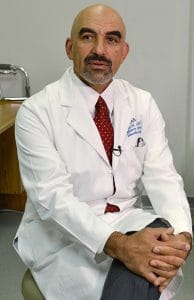Aneurysm Patient Encourages Others to Seek Screening
| Dec. 1, 2015 | What William Ford remembers most about the night he was rushed to the hospital in November 2014 is the pain.
“It was absolutely excruciating,” he said.

Williams Ford, 72, said he feels great now — a year after excruciating pain sent him to the hospital for treatment of an abdominal aortic aneurysm.
At first, his legs and hips hurt only when he moved, so he tried lying down in search of relief. When that didn’t help, his wife took him to the hospital in Jacksonville, a short drive from their home in Cabot. By the time they arrived, about 15 to 20 minutes after the pain began, the constant pain was unbearable.
Ford, 72, was diagnosed with a possible abdominal aortic aneurysm and was quickly transferred by ambulance to UAMS, where the diagnosis was confirmed.
“My first thought was ‘What in the world is an abdominal aortic aneurysm?’” said Ford.
An abdominal aortic aneurysm occurs when part of the abdominal aorta that supplies blood to the lower part of the body expands 1 ½ to 2 times its normal size, which is normally about 2 centimeters in diameter. While the condition is treatable, it can be life-threatening if the aneurysm ruptures. In fact, rupture of an abdominal aortic aneurysm is the 13th leading cause of death in men 60 and older in the United States.
Mohammed Moursi, M.D., UAMS chief of vascular surgery and director of the vascular surgery residency program at UAMS’ College of Medicine, said Ford had a symptomatic aneurysm that “was enlarging and pressing on his back and some of the nerves, which was causing pain.”
While Ford’s aneurysm hadn’t ruptured, the size of it and the fact that it was symptomatic meant that emergency surgery was necessary. He spent eight days in the hospital, including six days in the intensive care unit.

Mohammed Moursi, M.D., UAMS chief of vascular surgery, said screening for abdominal aortic aneurysms and other vascular conditions can help avoid emergency surgeries.
Ford’s experience with an abdominal aortic aneurysm was typical, but far from ideal.
“Ideally, we want to catch aneurysms before they cause a problem,” Moursi said.
That isn’t an easy task since many aneurysms are asymptomatic, especially in the early stages. Fortunately, screening can identify aneurysms long before they become an emergency.
Risk factors for an abdominal aortic aneurysm include age, a history of smoking, high blood pressure, high cholesterol and hardening of the arteries.
Moursi recommends that people 60 years of age or older with two risk factors or those who are 50 years old with a family member and one risk factor should get an abdominal ultrasound to check for an aneurysm.
“It is extremely important if people suspect they fall into those risk categories that they get screened and get it diagnosed,” Ford said. “Nobody ever wants to hear that they have this, but not knowing is worse.”
If an aneurysm is found, it will be measured. Smaller ones will be monitored, Moursi said, while those approximately 5 ½ centimeters in diameter are candidates for surgery.
Ford said his aneurysm was found years before it caused him pain. A specialist monitored the aneurysm for a while, but eventually Ford stopped going to him.
“I just got sick and tired of being monitored because this thing was not growing any larger,” he said, adding that he doesn’t recommend others follow his lead.
A year after his surgery, Ford said he feels great. He has gained back the 20 pounds he lost immediately following his surgery and is happy to be able to enjoy his retirement.
